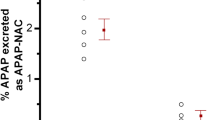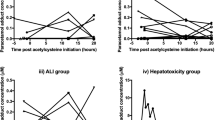Summary
To test the hypothesis that slow acetylators, who may have a greater risk of developing isoniazid hepatitis than rapid acetylators, are exposed to more acetylhydrazine and hydrazine, two toxic metabolites of isoniazid, the urinary excretion of hydrazino metabolites of isoniazid was measured following the ingestion of 300 mg isoniazid.
Slow acetylators (n=7) excreted significantly more isoniazid (32.4 vs 9.2% dose), acetylhydrazine (3.1 vs 1.6% dose), and hydrazine (1.0 vs 0.4% dose) in 24 h than rapid acetylators (n=5), whereas the excretion of acetylisoniazid and diacetylhydrazine was significantly lower. As the acetylation (i.e. detoxification) of acetylhydrazine is inhibited in the presence of high concentrations of isoniazid, a study was also made of the effect of a slow-release preparation that results in lower plasma concentrations of isoniazid on the production of hydrazino metabolites. The ratio of acetylisoniazid to isoniazid in urine was significantly increased in slow acetylators from 0.84 to 1.02 following administration of the slow release preparation, indicating increased acetylation of isoniazid. However, the excretion of diacetylhydrazine relative to the excretion of acetylhydrazine and hydrazine did not change.
It is concluded that exposure to toxic metabolites of isoniazid is increased in slow acetylators. Detoxification of the toxic metabolites was not enhanced by a slow-release preparation of isoniazid.
Similar content being viewed by others
References
Mitchell JR, Zimmerman HJ, Ishak KG, Thorgeirsson UP, Timbrell JA, Snodgrass WR, Nelson SD (1976) Isoniazid liver injury: Clinical spectrum, pathology, and probable pathogenesis. Ann Int Med 84: 181–192
Black M, Mitchell JR, Zimmerman HJ, Ishak KG, Epler GR (1975) Isoniazid-associated hepatitis in 114 patients. Gastroenterology 69: 289–302
Musch E, Eichelbaum M, Wang JK, v Sassen W, Castro-Parra M, Dengler HJ (1982) Die Häufigkeit hepatotoxischer Nebenwirkungen der tuberkulostatischen Kombinationstherapie (INH, RMP, EMB) in Abhängigkeit vom Acetyliererphänotyp. Klin Wochenschr 60: 513–519
Dickinson DS, Bailey WC, Hirschowitz BI, Soong SJ, Eidus L, Hodgkin MM (1981) Risk factors for isoniazid (INH)-induced liver dysfunction. J Clin Gastroenterol 3: 271–279
Timbrell JA, Mitchell JR, Snodgrass WR, Nelson SD (1980) Isoniazid hepatotoxicity: The relationship between covalent binding and metabolism in vivo. J Pharmacol Exp Ther 213: 364–369
Noda A, Hsu KY, Noda H, Yamamoto Y, Kurozumi T (1983) Is isoniazid-hepatotoxicity induced by the metabolite hydrazine? Sangyo Ika Daigaku Zasshi 5: 183–190
Lauterburg BH, Smith CV, Todd EL, Mitchell JR (1985) Pharmacokinetics of the toxic hydrazino metabolites formed from isoniazid in humans. J Pharmacol Exp Ther 235: 566–570
Timbrell JA, Wright JM, Baillie TA (1977) Monoacetylhydrazine as a metabolite of isoniazid in man. Clin Pharmacol Ther 22: 602–608
Iguchi S, Goromaru T, Noda A, Matsuyama K, Sogabe K (1977) Quantitative determination of hydrazines derived from isoniazid in man. Chem Pharm Bull (Tokyo) 25: 2796–2800
Wright JM, Timbrell JA (1978) Factors affecting the metabolism of (14C)acetylhydrazine in rats. Drug Metab Dispos 6: 561–566
Karlaganis G, Peretti E, Lauterburg BH (1987) Pharmacokinetics of isoniazid and acetylhydrazine in man using stable isotopes and capillary GLC-ammonia CI-MS. Experientia 43: 705
Evans DAP (1969) An improved and simplified method of detecting the acetylator phenotype. J Med Genet 6: 405–407
Timbrell JA, Wright JM, Smith CM (1977) Determination of hydrazine metabolites of isoniazid in human urine by gas chromatography. J Chromatogr 138: 165–172
Grob K, Grob G (1983) Immobilization of vingulated OV-17 and OV-17d based on combined surface bonding and cross-linking. J High Res Chromatogr Chromatogr Commun 6: 153–155
Baktir G, Bircher J, Fisch HU, Karlaganis G (1985) Capillary gas-liquid chromatographic determination of the benzodiazepine triazolam in plasma using a retention gap. J Chromatogr 339: 192–197
Lauterburg BH, Smith CV, Todd EL, Mitchell JR (1985) Oxidation of hydrazine metabolites formed from isoniazid. Clin Pharmacol Ther 38: 566–571
Ellard GA, Gammon PT (1976) Pharmacokinetics of isoniazid metabolism in man. J Pharmacokinet Biopharm 4: 83–113
Timbrell JA, Park BK, Harland SJ (1985) A study of the effects of rifampicin on isoniazid metabolism in human volunteer subjects. Hum Toxicol 4: 279–285
Hirata M, Aso Y, Hsu KY, Tabata T, Matsuyama K, Noda A, Iguchi S (1981) Metabolism of isoniazid and free hydrazine formation in isolated rat hepatocytes. J Pharmacobiodynamics 4: 145–147
Blair IA, Mansilla Tinoco R, Brodie MJ, Clare RA, Dollery CT, Timbrell JA, Beever IA (1985) Plasma hydrazine concentrations in man after isoniazid and hydralazine administration. Hum Toxicol 4: 195–202
Author information
Authors and Affiliations
Rights and permissions
About this article
Cite this article
Peretti, E., Karlaganis, G. & Lauterburg, B.H. Increased urinary excretion of toxic hydrazino metabolites of isoniazid by slow acetylators. Effect of a slow-release preparation of isoniazid. Eur J Clin Pharmacol 33, 283–286 (1987). https://doi.org/10.1007/BF00637563
Received:
Accepted:
Issue Date:
DOI: https://doi.org/10.1007/BF00637563




